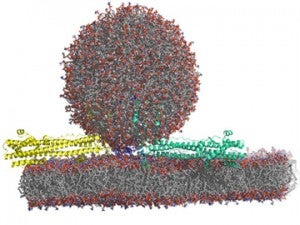Computational Biology
About
 Research in Computational Biology at UVA uses mathematical and computational techniques to analyze, explain, and predict biological systems.The past years have brought a dramatic increase in the amount of experimental data generated by high-throughput sequencing, proteomics, metabolic and gene expression profiling, and structural techniques. Simultaneously, the computational power we have available has continued to increase exponentially. We thus have huge data sets at our disposal coupled with the ability to make increasingly sophisticated analyses.
Research in Computational Biology at UVA uses mathematical and computational techniques to analyze, explain, and predict biological systems.The past years have brought a dramatic increase in the amount of experimental data generated by high-throughput sequencing, proteomics, metabolic and gene expression profiling, and structural techniques. Simultaneously, the computational power we have available has continued to increase exponentially. We thus have huge data sets at our disposal coupled with the ability to make increasingly sophisticated analyses.
Computational biology at UVA includes cutting-edge research in computational biophysics, genomics, computational structural biology, and computational systems biology. Our work is focused on addressing fundamental biological questions and understanding diseases of medical relevance, such as cancer, cardiovascular disease, lung infections in cystic fibrosis, drug-resistant bacterial infections, and influenza.
In addition to analyzing biological systems, many laboratories at UVA combine computational and experimental work, using sophisticated tools to analyze biomolecular behavior and then verifying predictions in the lab.
Faculty
Agaisse, Hervé
Genetic approaches, cellular and molecular biology of intracellular pathogen infection
Bajikar, Sameer Subhash
Systems biology approaches to study gene dosage in neurodevelopment and neurodevelopmental disorders
Bekiranov, Stefan
Computational Biology; Bioinformatics; Precision Medicine; Machine Learning/AI; Quantum Computing
Bourne, Philip E
Data Science
Campbell, John
The Neurobiology of Energy Balance
Condron, Barry G.
Regulation and Function Serotonergic Neurons During Development
DeSimone, Douglas W.
Cell Adhesion and Adhesion-Dependent Cell Signaling in Vertebrate Morphogenesis
Dolatshahi, Sepideh
Systems Immunology, Cancer Systems Biology, , Neonatal and Maternal Immunology
Fallahi-Sichani, Mohammad
Cancer systems biology, Single-cell quantitative biology, Computational modeling
Farber, Charles R.
Systems Genetics of Skeletal Development and Maintenance
Ford, Roseanne M.
Bacterial attachment and biofilms, microbial transport in porous media
Janes, Kevin A.
Systems-biology approaches to cancer biology and virology.
Li, Hui
Gene regulation in cancer, RNA processing; Epigenetic modification; Stem cell and development
Loughran, Jr., Thomas P
Hematologic malignancies; bone marrow disorders; leukemia; large granular lymphocyte (LGL)
Manichaikul, Ani W.
Statistical Genetics, Genetic Epidemiology, Biostatistics, Network analysis
Meliza, C. Daniel
Neural Mechanisms of Pattern Learning and Recognition in the Auditory System
Miller, Clint L.
Genetic variation, Complex diseases, Coronary artery disease, Genomics, Epigenomics, Regulatory mechanisms, Vascular biology, Pharmacology and Physiology
Naegle, Kristen
Regulation and function of tyrosine phosphorylation in complex networks
Papin, Jason A.
Systems biology, infectious disease, cancer, toxicology, metabolic engineering
Peirce-Cottler, Shayn M.
Tissue Engineering and Regeneration, Computational Systems Biology, Vascular Growth and Remodeling, Stem Cell Therapies
Platig, John H
Gene regulatory networks, Systems genetics, Multi-omic data integration, Network science
Ratan, Aakrosh
Genomics, Molecular Evolution, Algorithm Design and Analysis
Saucerman, Jeffrey J.
Roles of complex signaling networks involved in the regulation of cardiovascular function and disease
Sheffield, Nathan
computational biology & bioinformatics; high performance computing; epigenomics & chromatin; pediatric cancer; computational regulatory genomics; machine learning
Sheynkman, Gloria M.
Proteoform Systems Biology: proteogenomic approaches to uncover the role of proteomic variation in human disease
Swiatecka-Urban, Agnieszka
Regulation of cell-surface stability and intracellular trafficking of membrane proteins in epithelial cells
Syed, Sana
Understanding why a subset of children living in in low- and middle-income countries around the world develop growth and vaccine failure. Investigating the causes and progression of inflammatory enteropathies of the gastrointestinal lumen. Integrating data science-driven approaches with medicine to drive precision medicine.
Trinh, Bon Q
Understanding Protein and RNA regulations of gene expression via chromatin structure in myeloid cell development and diseases
Woodfolk, Judith A.
The immune response to common cold and allergens in health and disease.
Yang, Yaohua
Genetic and Molecular Epidemiology; Cancer; Human Microbiome
Zang, Chongzhi
Bioinformatics methodology development; Epigenetics and chromatin biology; Transcriptional regulation; Cancer genomics and epigenomics; Statistical methods for biomedical data integration; Advanced machine learning; Theoretical and computational biophysic
